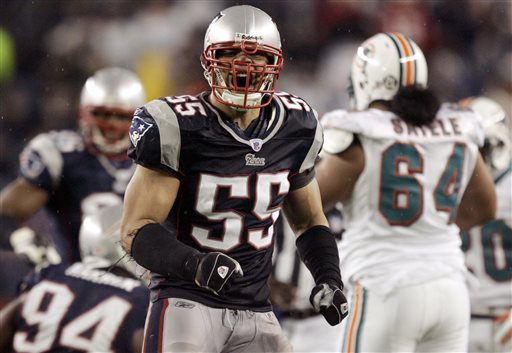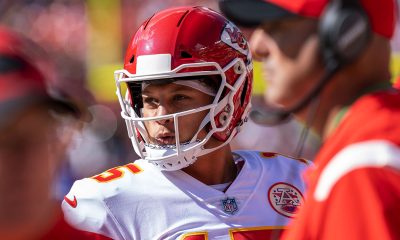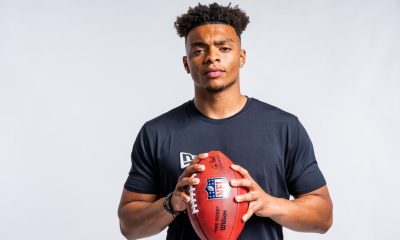Sports
‘Concern’ About Appeals of NFL Concussion Case Settlement


In this Dec. 23, 2007, file photo, New England Patriots linebacker Junior Seau (55) reacts after a defensive play during an NFL football game against the Miami Dolphins in Foxborough, Mass. (AP Photo/Elise Amendola, File)
HOWARD FENDRICH, AP Pro Football Writer
It’s been four years since lawsuits connected to concussions were first filed against the NFL, and even now that a settlement agreement finally has been approved by a federal judge, none of the hundreds of millions of dollars available to thousands of former players will be paid until any appeals are heard — and, after that, until claims are assessed.
“It’s a really good feeling, but it’s not over yet, because of the appellate process,” said Craig Mitnick, who represented more than 1,000 ex-players against the NFL. “It is more likely than not that within the next month, one of the attorneys that got involved late in the game, who represents a player or players who do not believe the settlement is fair, is going to court.”
Co-lead plaintiffs’ lawyer Christopher Seeger said he has “a modest concern” about appeals.
“The most common question we’ve heard from retired players has been: How quickly can we get help?” Seeger said. “As long as no appeals are filed, the settlement process will begin to roll out its benefits as soon as this summer.”
The lawsuits accused the NFL of failing to properly protect players from — or inform them about — the long-term risks of concussions.
Senior U.S. District Judge Anita Brody in Philadelphia approved the settlement with a 132-page opinion Wednesday after twice asking lawyers to do more work because of her concerns over whether the initial ceiling of $765 million for payments to players was too low. That figure, first announced in August 2013, was not increased, but the cap was removed. So it’s not known exactly how much the NFL will pay, aside from about $100 million in lawyers’ fees, along with millions more for concussion education and monitoring of ex-players’ health.
“It is an uncapped settlement, so it could be much more” than $765 million, Seeger said.
In theory, it also could be less.
Dozens of ex-players or their relatives rejected the settlement, including the family of Junior Seau, the Pro Football Hall of Famer who killed himself in 2012.
Last year, seven former players who objected to the proposed settlement — because it wouldn’t cover certain symptoms related to head trauma — unsuccessfully brought their complaint to the 3rd U.S. Circuit Court. One, Sean Morey, told The Associated Press no decision had been made about appealing Wednesday’s order.
The awards will depend on how long a player’s career was, his age, and his neurocognitive problems. Payouts could reach $1 million to $5 million for those diagnosed in their 30s and 40s with Parkinson’s or Lou Gehrig’s disease.
Former players do not need to prove problems were caused by football. They can seek funds even if they weren’t among the 5,000 or so who sued.
“What matters now is time, and many retired players do not have much left,” said plaintiff Kevin Turner, who has Lou Gehrig’s disease.
Once the settlement becomes effective, after any appeals are exhausted, eligible players — those who retired before July 2014 — will have 180 days to register with court-appointed claim administrators, reserving the right to seek payment.
After submissions are assessed, the league and players will be able to appeal the amount of an individual’s lump-sum payment.
“The process is one of my concerns,” said 58-year-old Brent Boyd, a former offensive lineman for the Minnesota Vikings. “The NFL’s strategy for dealing with retirees is delay, deny and hope we die.”
A finalized settlement allows the league, with annual revenues of about $10 billion, to have a sense of what this will end up costing. Team owners avoid the public spectacle of a trial. And the NFL did not admit liability.
Ex-players, meanwhile, “avoid years of costly litigation that … would have an uncertain prospect of success,” in NFL general counsel Jeff Pash’s words.
“The NFL got a huge PR problem off their plate. The attorneys got a huge payday. And the retirees are back at Page 1, where we were 10 years ago,” said Boyd, one of the original plaintiffs. “I’m afraid we will have to fight tooth and nail for these benefits.”
___
Associated Press Writer Maryclaire Dale in Philadelphia contributed to this report.
___
Follow Howard Fendrich on Twitter at http://twitter.com/HowardFendrich
___
AP NFL website: http://www.pro32.ap.org and AP NFL Twitter feed: http://twitter.com/AP_NFL
Copyright 2015 The Associated Press. All rights reserved. This material may not be published, broadcast, rewritten or redistributed.











































